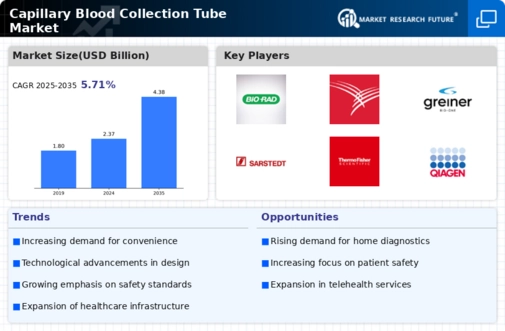Market Growth Projections
The Global Capillary Blood Collection Tube Market Industry is projected to experience substantial growth over the next decade. With an estimated market value of 2.37 USD Billion in 2024, the industry is expected to expand to 4.38 USD Billion by 2035. This growth trajectory suggests a compound annual growth rate (CAGR) of 5.73% from 2025 to 2035. Factors contributing to this growth include rising healthcare expenditures, increasing awareness about early disease detection, and advancements in blood collection technologies. The market's expansion reflects the critical role of capillary blood collection tubes in modern healthcare practices.
Shift Towards Home Healthcare Solutions
The Global Capillary Blood Collection Tube Market Industry is witnessing a shift towards home healthcare solutions, driven by the increasing preference for at-home medical services. Patients are increasingly seeking convenient and accessible healthcare options, prompting healthcare providers to adopt capillary blood collection tubes for home use. These tubes enable patients to conduct blood tests without the need for hospital visits, thereby enhancing patient compliance and satisfaction. This trend is expected to contribute to the overall market growth, as more individuals opt for home-based healthcare solutions that incorporate innovative blood collection technologies.
Increasing Prevalence of Chronic Diseases
The Global Capillary Blood Collection Tube Market Industry is significantly influenced by the rising prevalence of chronic diseases such as diabetes and cardiovascular disorders. These conditions necessitate regular blood monitoring, thereby increasing the demand for efficient blood collection methods. Capillary blood collection tubes offer a practical solution for frequent testing, making them essential in managing chronic health issues. As healthcare systems worldwide adapt to the growing burden of chronic diseases, the market is anticipated to expand, contributing to the projected growth to 4.38 USD Billion by 2035. This trend underscores the critical role of capillary blood collection in modern healthcare.
Technological Advancements in Blood Collection
Technological innovations play a pivotal role in shaping the Global Capillary Blood Collection Tube Market Industry. Recent advancements in materials and design have led to the development of more efficient and user-friendly blood collection tubes. These innovations enhance the accuracy of blood sampling and reduce the risk of contamination. For instance, the introduction of safety-engineered devices has improved the safety profile of blood collection procedures. As a result, the market is expected to grow at a CAGR of 5.73% from 2025 to 2035, indicating a robust future driven by continuous technological enhancements.
Rising Demand for Minimally Invasive Procedures
The Global Capillary Blood Collection Tube Market Industry is experiencing a notable increase in demand for minimally invasive procedures. This trend is driven by the growing preference for patient comfort and reduced recovery times. Capillary blood collection tubes facilitate quick and efficient blood sampling, which aligns with the healthcare industry's shift towards less invasive techniques. As healthcare providers adopt these methods, the market is projected to reach 2.37 USD Billion in 2024, reflecting a significant growth trajectory. The convenience and efficiency offered by capillary blood collection tubes are likely to further bolster their adoption in clinical settings.
Regulatory Support for Innovative Medical Devices
Regulatory bodies are increasingly supporting the development and approval of innovative medical devices, which positively impacts the Global Capillary Blood Collection Tube Market Industry. Streamlined approval processes and favorable regulations encourage manufacturers to invest in research and development of advanced blood collection technologies. This regulatory environment fosters innovation and enhances the availability of high-quality capillary blood collection tubes in the market. As a result, the industry is likely to benefit from increased competition and improved product offerings, further driving market growth in the coming years.



















